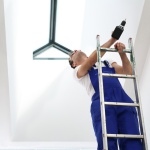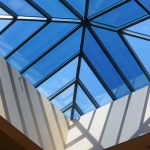
Threading the needle with a skylight to stitch an energy-efficient building
Everyone loves an environment that’s tailored to them, and skylights are no different. When it comes to choosing the right products for optimizing energy performance in buildings, understanding/managing the margins around the perfect fit can make any property manager/building owner feel claustrophobic and scared to commit.
Skylights can positively impact building energy performance by providing natural daylight and reducing the need for artificial lighting. However, our LEED-certified Artistic Skylights Manager, Marco Ferrazo, explains, “The skylight’s energy efficiency can be compromised if not properly chosen to mitigate solar heat gain, or if they lack the appropriate controls.”
Like a wingman to your building and its energy performance products, we’ve set out to explain some factors building designers should consider when mingling skylights into their projects for a match made in energy savings’ heaven.
Learn the love languages of building energy efficiency:
U-Factor: Can U-Feel the heat through the skylight?
The U-Factor asks how open this closed relationship is, or, how the skylight prevents heat from escaping the building. The U-Factor measures the rate of heat transfer through the skylight, with a lower U-Factor indicating better insulation and reduced heat loss during cold weather. Skylights with multiple panes of glass, Low-E coatings, inert gas fillings, and thermally broken frames tend to have lower U-Factors because they are designed to reduce heat transfer.
Solar Heat Gain Coefficient (SHGC): Keep your love lockdown
Like the yin to U-Factor’s yang, the SHGC measures the amount of solar radiation that passes in through the skylight. SHGC values range from 0 to 1, with a lower SHGC indicating that the window or glazing system allows less solar heat to pass through, making it more effective at blocking heat gain. This measurement is particularly relevant for regions with varying climate conditions, much like our own. Ferrazo also advises, “It’s important to not consider solar heat and visible light as the same property.”
Visual Light Transmittance (VLT): The sandwich of energy efficiency
Evaluating daylighting against electrical consumption, VLT measures the amount of visible light that passes through the skylight. It directly impacts the amount of natural daylight that enters a space and influences the overall visual comfort and aesthetics of the building’s interior.
VLT values range from 0% (completely opaque, no light transmission) to 100% (completely transparent, all light transmitted). This scale means a higher VLT value indicates better natural daylighting, allowing for less electrical consumption and reducing the need for artificial lighting. However, do note that in a warm climate, excessive VLT can lead to unwanted solar heat gain and may require additional cooling measures.
Energy Star skylights: Seal the energy-efficient deal
Ferrazo says, “Simply put, Energy Star is a single zone rating that identifies a product as being capable of meeting the maximum U-Factor of 2.29 (0.40).” If that’s not simple enough, which we suspect it might not be, think of Energy Star skylights as a big sibling seal of approval for the overall dedication and compatibility of the skylight to the sustainable mission. Products with this designation are designed to meet specific energy efficiency criteria set by the U.S. Environmental Protection Agency, making them a preferred choice for builders who want to reduce energy consumption, save money on utility bills, and contribute to environmental sustainability.
It is important to note that only some skylight models can make Energy Star-rated certification. In response, we have launched our ENERGY+ program that outlines which models meet or exceed SB-10 Ontario Building Code U-Value ratings.
A place for everything and everything in its place
As we enter the colder seasons, it’s important to ensure your building is cozying up with a skylight that meets the energy-efficiency qualifications necessary for your project and fits in with your building’s composition – snug as a bug in a rug. This investment not only contributes to energy savings but also enhances the overall comfort and ambiance of your space. Consulting with an Artistic Skylights building professional or energy specialist can help ensure you select the right skylight for your specific building and location.
As professionals in the business of punching holes in the ceiling, let us help you find a product match that rivals rocket-grade chemistry and leaves you feeling like John Bender at the end of The Breakfast Club.



